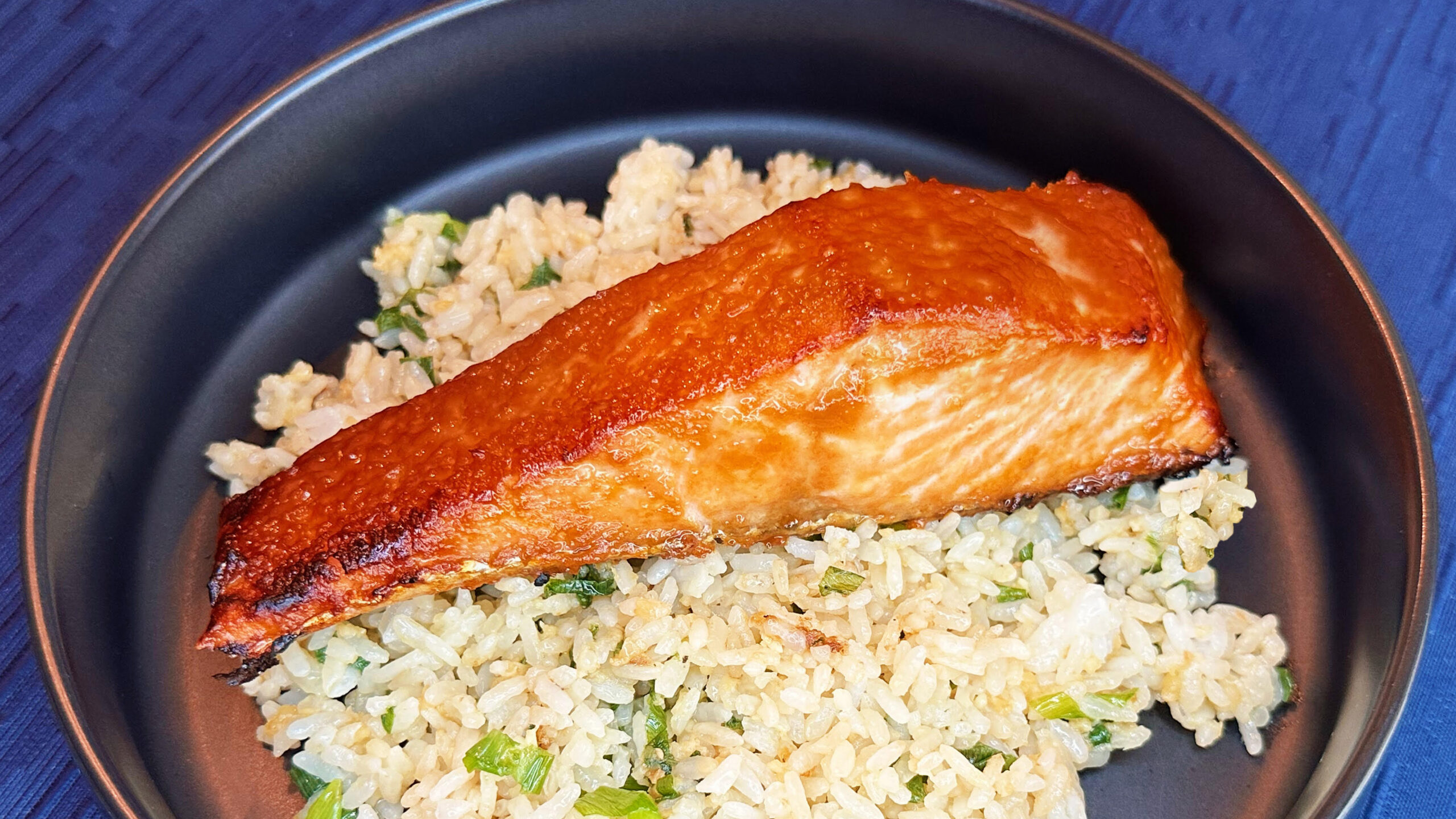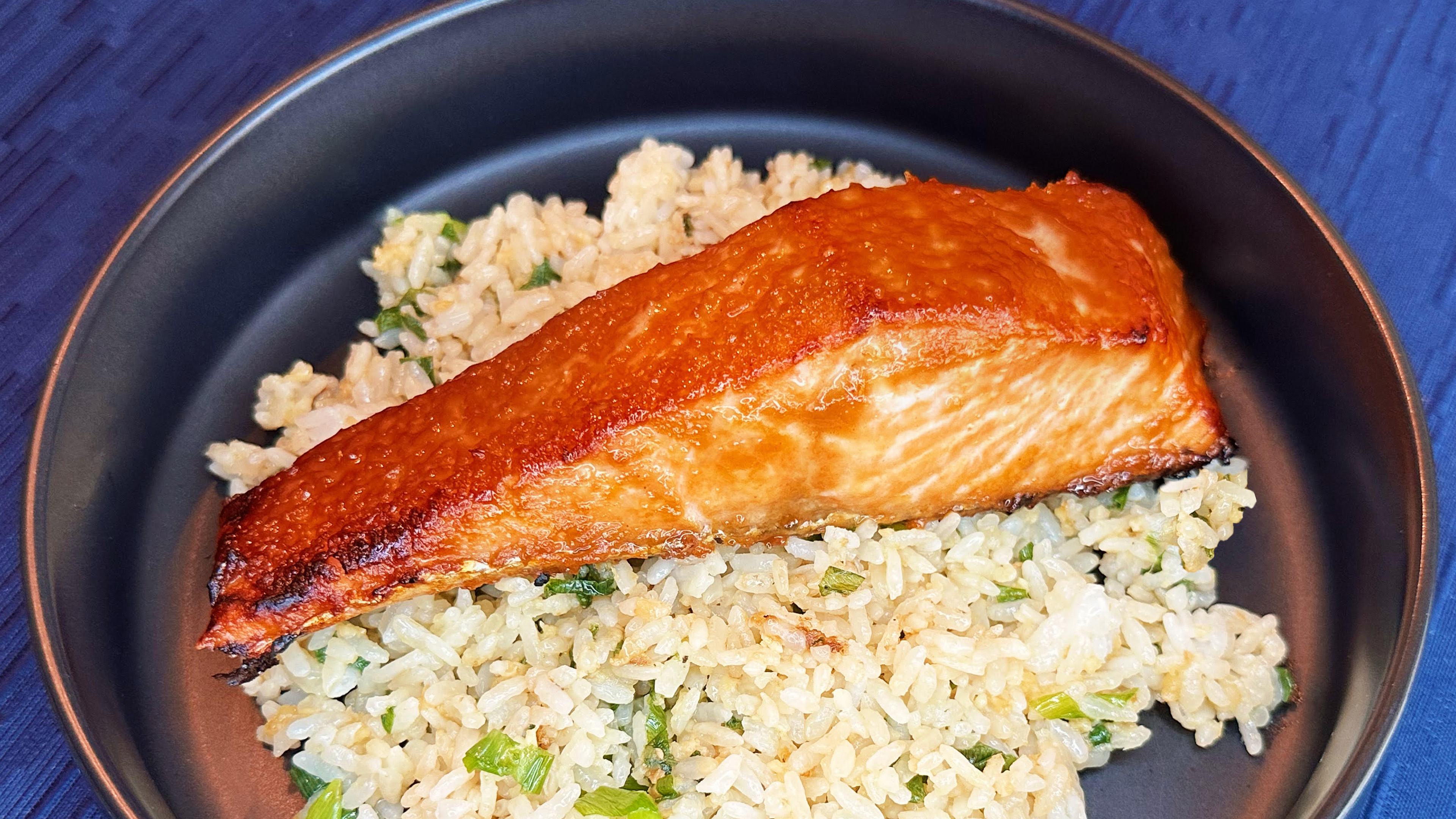Broiled Miso-Maple Glazed Salmon draws on two influences: my Canadian roots, where maple is a staple, and the iconic Nobu Miso-Marinated Black Cod which I have made many times and love.
Maple and salmon work together beautifully, just like the timeless pairing of miso and fish. Here, maple, miso, and salmon come together in perfect harmony. The ginger-scented fried rice, which will require cold or day-old rice, mirrors the glaze, soaking up the sweet-umami flavors of the salmon while providing a fragrant, supportive base.

Maple syrup in Canada
In Canada, the production of maple syrup starts with the spring thaw. Sugar maples are tapped when nights are cold and days are mild; clear sap—about 2% sugar—runs to buckets or tubing and is boiled in wide evaporators until it reaches about 66° Brix, the legal density for syrup. The result is filtered and graded from Golden to Very Dark, with darker grades bringing a deeper, more toffee-like flavor. Indigenous communities produced maple sugar and syrup long before commercial operations, and today Quebec remains the largest producer.
Cooks use maple syrup as more than a breakfast sweetener. Its gentle acidity and mineral notes make a clean-tasting sweetener for baked beans, vinaigrettes, roasted vegetables, and marinades. With fish—especially salmon, trout, or Arctic char—maple syrup adds a glossy finish and balances richness without masking the fish. Because sugars brown quickly, the key is timing: you want maple-based glazes to lacquer rather than burn. In the recipe below, the fillets are brushed with glaze and baked, then finished briefly under a broiler to caramelize the sugars in the glaze.
Miso for Umami
Miso is a fermented paste made from soybeans, salt, and koji (the fungus Aspergillus oryzae), often with rice or barley. During fermentation—anywhere from weeks to years—enzymes break proteins into amino acids, especially glutamates, and create savory nucleotides. That’s where the umami comes from: compounds that make foods taste fuller and more satisfying. White (shiro) miso is younger and milder; red (aka) miso is longer-aged and saltier; awase blends the two.
Pairing miso with maple syrup works because sweet and salty meet umami and gentle acidity. Maple brings sucrose and trace minerals that balance miso’s salt, and under heat the syrup caramelizes while miso’s amino acids take part in Maillard reactions, giving a glossy, savory-sweet finish. With salmon or trout, a thin glaze clings well and complements the fish’s natural oils without tipping into being cloying. ![]()
Ingredients
For the salmon:
- •Four 142 gram (5-ounce) MOWI salmon fillets, skin-on
- •3 tablespoons white miso paste (other miso may be substituted)
- •2 tablespoons pure maple syrup
- •1 tablespoon soy sauce (use a gluten-free soy sauce or tamari to make this dish GF)
- •1 tablespoon rice vinegar
- •1 teaspoon grated fresh ginger
- •1 teaspoon toasted sesame oil
- •Neutral oil or parchment (for the baking sheet)
- •Garnish options: toasted sesame seeds and thinly sliced scallions
For the Ginger-Scallion Fried Rice:
- •2 tablespoons neutral oil (avocado, canola, or vegetable)
- •2–3 scallions, thinly sliced (whites and greens separated)
- •1 tablespoon finely grated or minced fresh ginger
- •1 garlic clove, minced (optional)
- •473 ml (2 cups) cooked rice, cold or day-old
- •1 tablespoon soy sauce or tamari
- •1 teaspoon sesame oil
- •Fine salt, as needed


Preparation
For the salmon: Preheat oven to 200°C (400°F). Prepare a baking sheet by lining with parchment paper or lightly oiling. In a small bowl, make a glaze by whisking miso, maple syrup, soy sauce, rice vinegar, ginger, and sesame oil until smooth
Pat the salmon fillets dry and place skin-side down on the baking sheet. Brush tops and sides with half the glaze. Let them rest for 10-15 minutes.
Bake at 200°C (400°F) for about 10 minutes, until the internal temperature reaches 57°C (135°F). Meanwhile, prepare the Ginger Fried Rice.
For the Ginger-Scallion Fried Rice: Heat oil in a large skillet or wok over medium-high heat. Add scallion, ginger, and garlic; stir-fry 30-45 seconds until fragrant. Add rice, breaking up clumps. Stir-fry 2-3 minutes until heated through. Season with soy sauce, sesame oil, and salt. Cook another 30-60 seconds until everything is incorporated.
To finish and serve: Brush salmon with remaining glaze. Switch oven to high broil and cook, watching carefully, until the glaze caramelizes and the internal temperature reaches 63°C (145°F), 1–2 minutes. Let rest 2 minutes.
Spoon the fried rice onto plates and nest the glazed salmon filet on top, letting a little glaze drip onto the rice. Sprinkle with sesame seeds and extra scallions.

